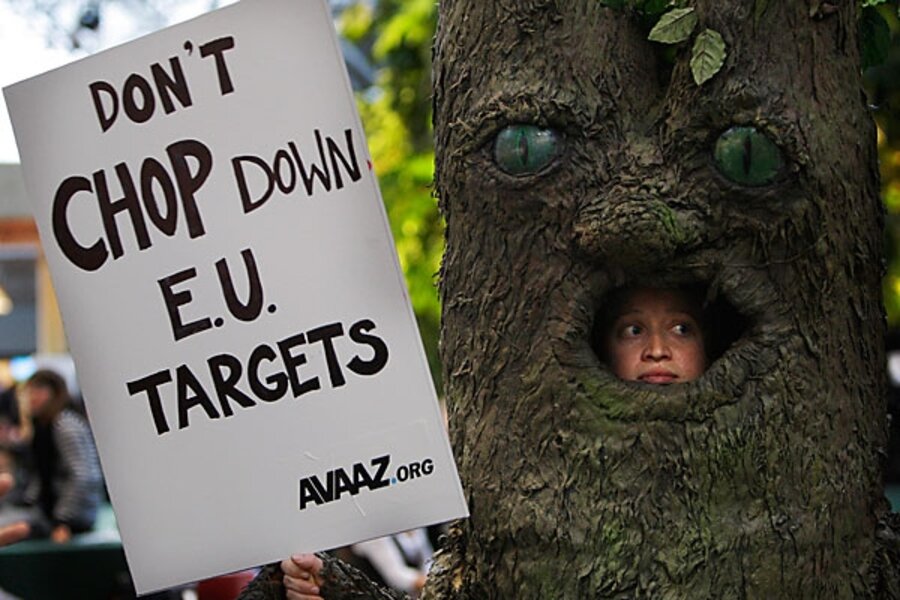At Copenhagen climate change talks, researchers tout keeping trees as a solution
Loading...
COPENHAGEN, DENMARK – If you want to help apply the brakes to global warming, save some trees – especially if they are in the tropics.
That's the simple idea behind one approach to reducing greenhouse-gas emissions. And it's gained enough traction to become one of the few success stories so far at UN-sponsored global warming summit here in Copenhagen.
Delegates from more than 190 countries are grappling with difficult issues of money and emissions targets as they try to craft a follow-on to the 1997 Kyoto Protocol.
But while negotiators engage in diplomatic arm wrestling over emissions reductions and funding to help poor countries adopt cleaner technologies, and scientists present evidence of the dangers of carbon emissions, they are having a much easier time getting behind avoiding additional carbon dioxide (C02) emissions by keeping trees in the ground. It's an approach known by the acronym "REDD."
Talks over REDD's inclusion in any new climate agreement "are moving very well," said Markku Kanninen, senior scientist at the Center for International Forestry Research (CIFOR) in Bogor, Indonesia. "It's one of the few issues that have no big difficulties," he told reporters.
In many ways, the approach is seen as low-hanging fruit in reducing carbon dioxide emissions. Tropical forests are losing some 32 million acres a year, researchers say. This pumps about 1.6 billion tons of carbon dioxide into the atmosphere annually.
During the 1990s, deforestation accounted for some 20 percent of global CO2 emissions from human activities. That fell to 12 percent in 2008, according to the latest figures from the Global Carbon Project. Others have dubbed that an underestimate. And scientists with the project acknowledge large uncertainties in their estimate.
Still, holding back deforestation and forest degradation can be an important arrow in the emissions-mitigation quiver, many analysts say. And it provides a way for developing countries, who have resisted economy-wide emission reductions as a threat to lifting their people out of poverty, to take an active role in the fight against global warming.
Last month, for instance, Brazil offered to reduce its carbon dioxide emissions by 36 to 39 percent below current levels by 2020. Some 80 percent of those cuts would come from halting deforestation. The offer hinges on getting sufficient aid from rich countries to ramp up the country's efforts.
On Tuesday, negotiators made significant progress on the scientific and technical issues surrounding REDD, according to Rane Cortez, a forest carbon-policy advisor for the Nature Conservancy, an international conservation group that has helped pioneer the concept.
Specific language is still being worked out, she says. But the current draft includes advice on how countries can address the local factors driving deforestation. The draft has provisions for monitoring and ways to figure out how many tons of carbon emissions have been retained rather than released into the atmosphere.
Finally, negotiators are trying to ensure local people are treated fairly if their traditional lands become the focus of REDD projects. And negotiators are working on language aimed at actively engaging forest residents in monitoring and verification efforts.
But issues remain to be worked out regarding property rights – critical for determining who gets any money from the sale of carbon credits earned through avoiding deforestation. And negotiators are haggling over provisions that could be interpreted as giving traditional forest owners veto power over projects on their lands – something governments trying to adopt "national" REDD programs balk at.
Still, given the resistance to the REDD idea among many indigenous groups when the concept was first proposed in 2005, "I'm impressed with how far we've come," says Tracy Johns, a policy analyst at the Woods Hole Research Center in Woods Hole, Mass.
Whatever the outcome, REDD is a CO2 emission-control approach that several developing countries can dig into quickly. In the past year, some 40 countries started to lay the groundwork for participating in a REDD program, according to Arild Angelsen, an economist at the Norwegian University of Life Sciences who compiled a new CIFOR report on REDD, released today.
But he and his CIFOR colleagues caution that the path to implementing REDD will be rocky. Some countries are better prepared to dive in than others. Poorer countries might want to start indirectly, by changing agriculture and land-use polices, rather than immediately adopting a turn-key system for monitoring and enforcing deforestation efforts directly. Much hinges on the long and short-term financial commitments rich countries may promise in any new climate agreement.
In the meantime, roughly 100 projects of varying size are underway as countries experiment with REDD-like mechanisms.
The Nature Conservancy, for instance, is working with the district of Berau in Indonesian Borneo and with the Indonesian government to set up a REDD mechanisms there. The program is the next iteration of a pilot project the Conservancy undertook in the Noel Kempff Mercado National Park in Bolivia. The effort was the first REDD project to earn independent certification for avoiding emissions, although Nature Conservancy officials acknowledge that the project was not an unqualified success.
By scaling an experiment up to an entire political district – which is the size of Belize – rather than covering one national park, the team hopes to take lessons learned from Noel Kempff and apply them in a larger setting that begins to approach the political and economic complexity of an entire country. Local communities hold title to some of the land. Other tracts are used for palm-oil plantations, mining, and timber harvesting.
"Working out a strategy for all those land-use types and for all of those stakeholders really helps us picture how a national system might work," Ms. Cortez says.
A look at the challenges to preserving Indonesia's tropical forests.





